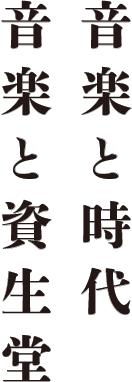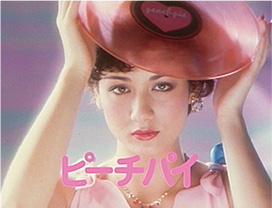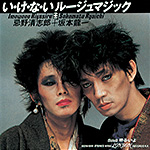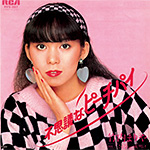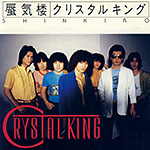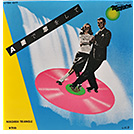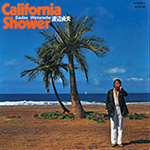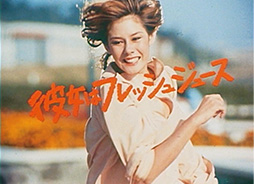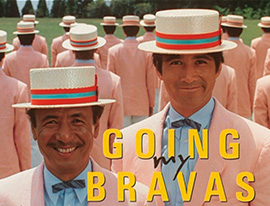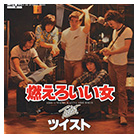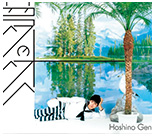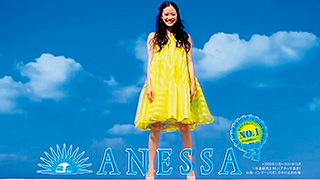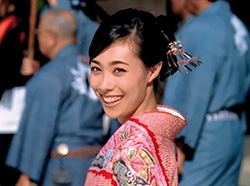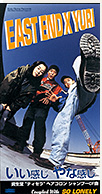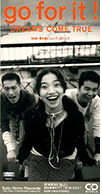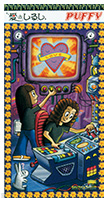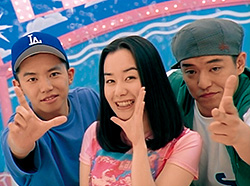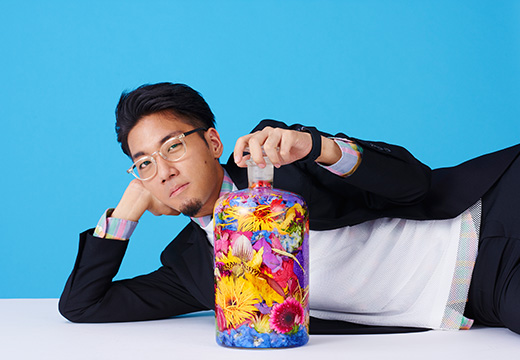
「景気不景気を考へるより、流行を考へねばならぬ立場にあります」という言葉は1920年に発表された資生堂の広告における一文である。静止画であった広告がCMで動き始め、新しいキャッチーさを獲得していくその過程は、行き先は同じでも、汽車が同じ線路の上でやがて美しい流線型を描く新幹線へと変化してゆくようなものではないだろうか。なんて上品な例えをしてみたけれど、誰しも実際にあまたある資生堂のCMを見てみれば、その変化と時代の移り変わりについて感じるところがあるだろう。
In 1920, Shiseido published an ad with the slogan, “From our standpoint, we must contemplate trends rather than the state of the economy.” The still image ad sprang into motion as a TV commercial, and this new and catchy transformation was just like a train on a track metamorphosing into a beautifully streamlined bullet train heading down the same path. This is just an attempt to paint you an elegant picture, but we’re sure that anyone who actually sees the myriad of Shiseido commercials would feel the transformation that has occurred over time.

世間一般にTVが普及し、止まっていた広告が活動を始めたとき、同時に必要とされたものが音楽である。資生堂においても60年代から本格的に取り入れられていった動画表現において、この音楽も、時代とともに進化していくこととなる。今回はそこにフォーカスを当てつつ資生堂と時代の変遷を見てみたい。
その試みが始まった60年代、資生堂のキャンペーンの一環として始まったCMにおける音楽は、当初の「キャンディトーン」等飽くまで商品説明のBGMに徹しているもの、もしくは「ファッションベイル」のように商品名をそのまま歌にしたものが多い。動画表現自体が先進的であった時代とはいえ、音楽はコンセプトを引き立てるためのひとつの手段といった趣で、洗練されたプロダクションはそれに注力されている。
With the spreading popularity of television sets, still image ads began to take on motion which simultaneously triggered the need for music to accompany the visuals. Shiseido started making full-motion TV commercials in the 1960s, and the music used in these ads has also evolved over time. In this issue, we would like to focus on the music that has evolved along with Shiseido and the changing times. When it all started in the 1960s, the music used as part of Shiseido’s marketing campaigns was purely background music for promoting products such as for the early “Candy Tone” commercials, or product names were incorporated directly into the jingle lyrics as for “Fashion Veil.” It was a period in which motion picture itself was considered leading-edge, and music was used in polished productions merely as a tool to enhance the concept.

70年代に入ってから徐々にCMはカタログ的なビジュアルから脱却し、イメージを想起させる映像に近づくこととなる。「ラブインカラー」では商品名と関係のない“電話”が楽曲の歌詞、ビジュアルともにキーとなっている。キャンペーンに紐付けて制作されていたBGM的な音楽が、演出の延長線上で歌詞や言葉を身につけるようになるのだ。
その中でも転機となったのがりりィ歌唱による「彼女はフレッシュジュース」からの一連の作品である。それまではCM音楽というものは飽くまでBGMであり、レコード会社からも冷ややかな視線を注がれていたそうだ。しかしビジュアルとともに強烈な印象を残す楽曲は、それだけでも人々に訴求力をもつのではないか。そこに目をつけた業界の人間がCMソングをレコードにして単体でもリリースを行うようになったという。ここから“CMソング”は“イメージソング”へ、CMにおける音楽の立ち位置は大きく変わり、音楽業界からも注目されることとなる。
As we entered the 1970s, TV commercials gradually shed the catalogue-like visuals and gravitated toward image-evoking visuals. For “Love in Color,” the visuals together with the lyrics of the tune “Denwa” (Telephone), which was unrelated to the product name, both played a key role in the commercial. Music that used to be produced as background music for marketing campaigns was gradually infused with lyrics and words and incorporated as an integral part of the production.
The turning point occurred after the release of a series of songs sung by singer-songwriter Lily, starting with “Kanojo wa Fresh Juice” (My Girlfriend is Fresh Juice). Until then, music in TV commercials, considered just background music, was apparently getting the cold shoulder from record companies. It became apparent however that the visuals combined with music that left an imperceptibly deep impression on the consumer had the power of persuasion. People in the industry latched onto this and began releasing songs from TV commercials as record singles. From this point on, these “TV commercial songs” became “image songs” which greatly changed the stance of music within TV commercials and garnered the attention of the music industry.

70年代後半に渡辺貞夫が音楽を提供するようになった「ブラバス」シリーズで、彼自身が後々映像でも登場するように、音楽と映像の関係値がさらに高まっていくのが80年代である。この頃にはキャンペーンにおける様々な要素と音楽が一連の大きな作品として機能しているCMが数多く制作され、その先進的なコンセプトを支えるために前衛的なアーティストが起用されている。歌謡曲的な時代からJ–POP的な時代への変化において、いち早くアーティスト寄りのミュージシャン(坂本龍一、EPO等)を起用しているのも印象的だ。彼らはビジュアルをより加速させるスタイリッシュな楽曲を提供していた。
In the late 1970s, Sadao Watanabe began providing his music for the Bravas series and later began appearing in the TV commercials that segued into the elevated relationship between music and visuals of the 1980s. During this period, a countless number of commercials were produced that merged various elements with music into one huge production, and featured avant-garde artists who were the cornerstone of this innovative concept. As the era of Japanese popular songs moved on to the era of modern J-POP, Shiseido was in the forefront to take on artist-type musicians (Ryuichi Sakamoto, EPO, etc.). These musicians provided stylish songs that further enhanced the visuals.

90年代にはJ–POPの時代が本格的に到来する。当時のJ–POPスターたちが登場するCMは時にオシャレに、時に元気に人々に語りかける。また、これらの楽曲はCMソングではあるがCDリリースを意識されたものも多く、キャンペーンのためだけに作られた楽曲とは少々一線を画す。そのようなこともあり、アーティスト本人が登場するCMが急激に増加している。CDが100万枚以上売れた時代における彼らのカリスマ性はそのままCMの映像にも封じ込められているようだ。実際資生堂が全ての要素を連動させて行っていた“キャンペーン”という手法は93年を最後に終わっている。アーティスト性が重要視され、かつもてはやされた時代だからこそCM表現もこのように変化していったのであろう。この流れは2000年になっても続くことになる。
In the 1990s, J-POP music became firmly rooted in the Japanese music scene. The J-POP stars who appeared in the TV commercials during this era were at times cool and stylish and at other times cheerful and energetic in delivering their message to consumers. Although the songs were created for commercials, many were geared toward CD release and were a much different breed from songs created solely for campaign purposes. For this reason, there was a sharp jump in commercials with appearances by the artists themselves. It was as if the charisma of these artists who sold over a million CDs was also locked into the visuals of the TV commercials. In 1993, Shiseido put an end to these “campaigns” which incorporated all the elements. It was an era in which artistic talent was praised and idolized, and it is likely that commercials had evolved to reflect that. This trend continued on into 2000.
そしてここ数年はどちらかというと音楽を大きく打ち出したCMは少し減っている気がする。これに関して言えば90年代中ほどの音楽業界のバブルから一段落して大きな求心力をもつものが昔に比べて減ったことや、ひとつの楽曲で大きな先進性を示すのが少し難しくなっている、といった理由があるのではないか、と感じる。一方で力強いコピーが押し出された映像がまた増えているのではないだろうか。ただここに至るには大きな流れを今一度考える必要がある。
In the last few years, there seems to be fewer commercials that spotlight the music. We feel that this may be because there is no real unifying force in the music industry now as compared to the bubble period of the 1990s, and also because it has become difficult to demonstrate a spirit of innovation based on just one song. On the other hand, there seems to be a rise in powerful ad copies. To explore the reason behind this, we need to look at the overall course of events.
このように時系列で並べてみれば、時代時代において資生堂のCM表現はある点で一方向に変化しているのがよくわかる。特に強く感じるのは現代に近づくほど演者のアーティスト性、自立性が強まっていくことだ。着せられている女性から選びとって着る女性へ、自立した女性へ。特にここ数年はコピー中心の(それも旧来のナレーション的な手法でなく演者自身が発言する)CMの比率が多い。それは見たとおり自立した女性という現代の姿を描いているのではないだろうか。そしてそういった時代へ女性を先導する。マネキンからアーティストになり、最後は力強く語る。最新のCMではルックスだけでなくむしろその個性的な振る舞いが人々を魅了しているレディー・ガガが起用されたのも頷けるだろう。
ある時代における女性の美は未来から見てみれば当時の“流行”そのものであり、またその“流行”とともにあるものが音楽である。つまりは女性の美を一貫して創っていくことは時代とともに変化していくこととほぼ同義である。一方で資生堂は美を創る会社である。ゆえに時代とともに、ではなくいつも少し先に“流行”のレールを敷かなければならないのだ。いつの時代も少し先にある新しい音が聞こえてくる理由はここにある。
In looking at this timeline, it becomes clear that Shiseido’s commercials are evolving in one direction from a specific point. In particular, the artistic talent and individualism of the actors in the commercials seem to be getting stronger as we get closer to the present era. Women who used to wear what they were told are choosing their own wardrobe and becoming more independent. The number of copy-oriented ads (using the artists’ actual voices rather than narrations like in the past) is on the rise particularly in these last few years. These commercials seem to represent the independence of women today, and are leading women toward this type of era. A transformation is taking place from mannequin, to artist, into women who can speak their minds with confidence. We can probably all agree to the aptness of the appointment to the latest commercial of Lady Gaga, a woman who draws people in, not just with her looks, but also with her unique demeanor.
From the standpoint of the future, the beauty of women in a particular era is the “trend” of that era, and accompanying that “trend” is music. In other words, building a consistent standard of beauty for women is analogous to changing along with the times. As Shiseido is in the business of creating beauty, we can’t just move along with the times, but we must always be one step ahead, blazing trails for trends. This is the reason that, in any era, we are always in tune to new music that’s ahead of its time.



